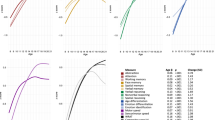Abstract
A model is presented for the changes in familial resemblance as a function of age. The model allows for separate developmental components of genetic and environmental effects and for the influence of earlier phenotypic values on current measurements. Genetic and environmental effects may be specific to occasions or constant over time. Expected covariances are derived within individuals and between relatives measured at different ages. Parameter substitution shows that models with different assumptions about the mechanism of development yield different predictions for temporal changes in family resemblance. The application of the model is illustrated by the analysis of published longitudinal data on cognitive development. The data suggest that the continuity of cognitive performance over time and the increase in heritability with age reflect the cumulative long-term effects of a single set of genes expressed throughout development. The quality of the shared environment changes from family to family over time but appears to exercise a long-term effect on cognitive development.
Similar content being viewed by others
References
Carey, G. (1985). Sibling imitation and contrast effects.Behav. Genet. (in press).
Corey, L. A., Eaves, L. J., Mellen, B. G., and Nance, W. E. (1986). Testing for developmental changes in gene expression on resemblance for quantitative traits in kinships of monozygotic twins.Genetic Epidemiol. (Submitted).
Eaves, L. J. (1978). Twins as a basis for the causal analysis of personality. In Nance, W. E. (ed.),Twin Research: Psychology and Methodology, Alan R. Liss, New York, pp. 151–174.
Fischbein, S. (1981). Heredity-environment influences on growth and development during adolescence. In Gedda, L. L., Parisi, P., and Nance, W. E. (eds.),Twin Research III. Intelligence, Personality and Development, Alan R. Liss, New York, pp. 211–226.
Hay, D. A., and O'Brien, P. (1981). The interaction of family attitudes and cognitive abilities in the La Trobe Twin Study of behavioral and biological development. In Gedda, L. L., Parisi, P., and Nance, W. E. (eds.),Twin Research III. Intelligence, Personality and Development, Alan R. Liss, New York, pp. 235–250.
Martin, N. G., and Eaves, L. J. (1977). The genetical analysis of covariance structure.Heredity 38:79–95.
McGue, M., Wette, R., and Rao, D. C. (1984). Evaluation of path analysis through computer simulation of incorrectly assuming independent distribution of familial correlations.Genet. Epidemiol. 1:255–270.
Plomin, R., and DeFries, J. C. (1985).Origins of Individual Differences in Infancy: The Colorado Adoption Project, Academic Press, Orlando, Fla.
Rao, D. C., Morton, N. E., and Yee, S. (1976). Resolution of cultural and biological inheritance by path analysis.Am. J. Hum. Genet. 26:331–359.
Wilson, R. S. (1972). Twins: Early mental development.Science 175:914–917.
Wilson, R. S. (1978). Synchronies in mental development: An epigenetic perspective.Science 202:939–948.
Wilson, R. S. (1983). The Louisville Twin Study: Developmental synchronies in behavior.Child Dev. 54:298–316.
Young, P. A., Eaves, L. J., and Eysenck, H. J. (1980). Intergenerational stability and change in the causes of variation in personality.Person. Indiv. Diff. 1:35–55.
Author information
Authors and Affiliations
Additional information
This research is supported by Grants AG-04954 and HL-31010 from the National Institutes of Health. We thank Dr. N. G. Martin for his helpful criticism.
Rights and permissions
About this article
Cite this article
Eaves, L.J., Long, J. & Heath, A.C. A theory of developmental change in quantitative phenotypes applied to cognitive development. Behav Genet 16, 143–162 (1986). https://doi.org/10.1007/BF01065484
Issue Date:
DOI: https://doi.org/10.1007/BF01065484




